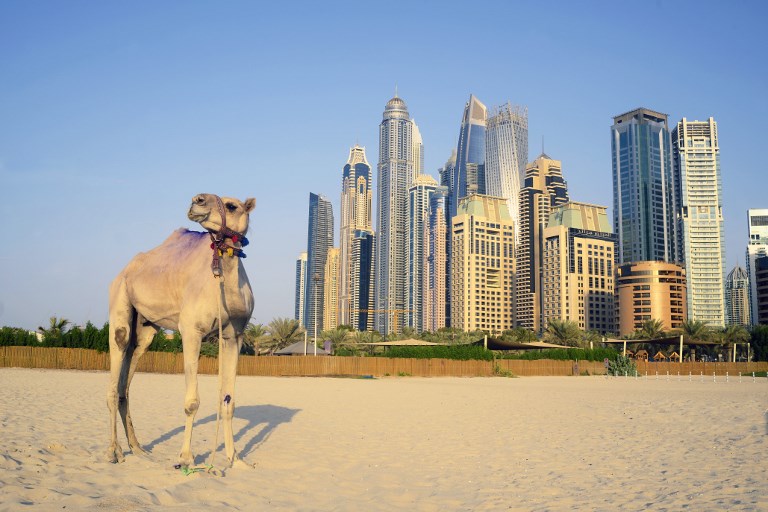São Paulo – Nine Arab cities rank among the top 100 city destinations in 2018, according to a survey of international arrivals in 600-plus locations around the world. The list is part of a report released last week by international market research company Euromonitor International. The only Brazilian city to make the ranking is Rio de Janeiro, at 94th. Asia, the leading region, is home to 41 of the 100 top destinations.
The nine Arab cities are Dubai (pictured at the beginning of this article), in the UAE – the only one to make the top 10 , at 7th; Mecca, 21st and Riyadh, 40th, both in Saudi Arabia; Cairo, Egypt, 50th; Dammam (Saudi Arabia), 61st; Jerusalem, Palestine, 63rd; Marrakech, Morocco, 78th; Abu Dhabi, UAE, 95th; and Doha, Qatar, 98th.
The top 15 cities in the overall ranking are Hong Kong (China), Bangkok (Thailand), London (United Kingdom), Singapore, Macau (China), Paris (France), Dubai (UAE), New York (USA), Kuala Lumpur (Malaysia), Shenzhen (China), Phuket (Thailand), Istanbul (Turkey), Deli (India), Tokyo (Japan) and Rome (Italy).
Eight of the ten top destinations in the Middle East and Africa are Arab cities: Dubai, Mecca, Riyadh, Cairo, Dammam, Marrakech and Abu Dhabi. Dubai ranks first with an expected 16.5 million arrivals in 2018, up 5.5% from 2017. Mecca, the holy city in Saudi Arabia, comes next at 9.5 million arrivals, up 9.9%. Abu Dhabi placed 10th at nearly 2.5 million arrivals, up 7.1%. The two non-Arab cities on the list are Johannesburg (South Africa) in 3rd and Tel Aviv (Israel) in 9th.
The Arab city to see the strongest growth was Jerusalem, which is expected to welcome over 4.8 million travelers, up 37.5%; Cairo is the second-strongest growing Arab destination, at 4.8 million arrivals, up 11.5% from 2017.
According to Euromonitor, the ranking of top destinations in the two regions is strongly focused on the Middle East and North Africa, with no Sub-Saharan cities included. However, the Single African Air Transport Market (SAATM) launched in January 2018 – and signed by 23 AFrican Union member countries – means air connectivity in the continent is poised to improve in years to come.
With heavily oil-based economies, countries like the UAE and Saudi Arabia are working to diversify their economies and to open up to international tourists.
Saudi Arabia and the UAE are actively diversifying their tourism, targeting families and groups who seek experiential travel as well as solo travelers seeking health and wellness or adventure. While Dubai and Abu Dhabi are by far the biggest destinations in the UAE, “dispersal to other emirates is increasingly promoted.”
The document also lists “four cities to watch”: Mumbai (India), Porto (Portugal), Osaka (Japan) and Jerusalem (Palestine). With “relative stability and a strong marketing push,” Jerusalem saw arrivals climb 32% in 2017, with 38% growth expected in 2018. “After a slump between 2013 and 2015, arrivals are now back above 2012 figures,” the report reads
The Americas
The top-ranking cities in the Americas are in North and Central America. Buenos Aires, Argentina at 89th and Rio de Janeiro, Brazil at 94th are the only South American cities on the top 100. The Brazilian city is expected to see 2.4% growth at 2.3 million arrivals in 2018, while the Argentinian one should welcome 2.4 million travelers, up 0.5%.
The top 10 for the Americas, in descending order, are New York (USA), Miami (USA), Los Angeles (USA), Las Vegas (USA), Cancun (Mexico), Orlando (USA), Toronto (Canada), Punta Cana (Dominican Republic), Vancouver (Canada) and San Francisco (USA).
Global performance of city destinations
According to the report: “Global inbound arrivals are expected to be up 5% to 1.4 billion trips in 2018. At the same time, arrivals to this year’s top 100 city destinations are set to grow by 7.5%. This is a continuation of a trend which sees the top cities outperforming global arrivals growth, with city hubs extending their importance for the global travel industry. In this year’s ranking, Asia continues its rise. The region accounts for 41 out of the top 100 cities. This number has steadily risen from 37 in 2012.”
“The biggest loser is the Middle East and Africa region, with cities such as Jerba and Sousse in Tunisia, or Sharm el Sheikh in Egypt dropping out of the ranking in past years, mainly due to terrorist attacks and subsequent slumping demand. Cairo, however, is seeing a resurgence.”
Dubai
Euromonitor said the Dubai Tourism Vision 2020 aims to welcome 20 million visitors by that year. The local tourism board is promoting the emirate as a leisure and business destination, and “policies were introduced” to increase arrivals from new source markets. These included new visa-upon-arrival policies, no charge for transit tourists for up to 48 hours stays, and optional extended-stay visas for up to 96 hours.
Mecca
According to the report, the top Saudi destination is “trying to facilitate religious tourists through the use of smartphone applications. The Ministry of Hajj and Umrah offers official applications” for pilgrims, like the translation app Manasikana. The Hajj is the major pilgrimage to Mecca taken by millions of Muslims every year, on a date determined by the Islamic calendar. The Umrah is the minor pilgrimage, which can be taken at any time of the year.
According to the Euromonitor report, the “Hajj e-bracelet was launched in 2016 after a large and deadly stampede in 2015. It is of vital importance in managing the large number of pilgrims during Hajj, and acts as an electronic GPS bracelet. An app can read the bar code to identify pilgrims. In 2018, the organizers also installed a number of sleeping pods to provide low-cost solutions in busy areas such as the airport or train stations.”
Translated by Gabriel Pomerancblum




